Most trekkers in Nepal, both foreign and locals, make use of Nepal tea houses. These small hotels, known as Bhatti in Nepalese, offer a place to sleep and home-cooked meals. This obviates the need to cart around a tent and food.
Quality varies according to competition and number of customers, which of course is a factor of footfall. Popular routes like the EBC Trek and treks in the Annapurna Region have a wide variety of quality tea houses, whereas less well trodden paths in the far west and east of Nepal are characterised by rustic and very basic tea houses.
Nepal Tea Houses Accommodation and Facilities
Toilets, Showers and Communal Areas
In the popular trekking regions, the tea houses that are at a lower altitude tend to be very nice. These often boast flush toilets and hot showers (in return for a $4 fee).
As you move higher up into the Himalayas the toilet and shower facilities become more and more basic. From standard toilet systems without flushing mechanisms (you use a bucket of water to flush), to long drops, indoors and outdoors.
Check out prices for your EBC trek with our preferred local guides.
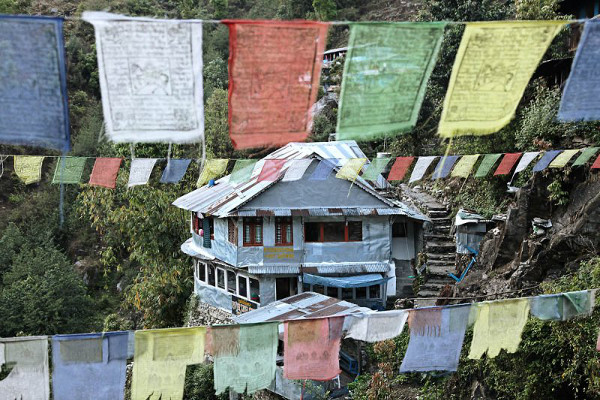
Hot water and showers become increasingly scarce as you ascend in altitude. At the more remote Nepal tea houses, you can pay for a pot of hot water to clean yourself.
Most tea houses have a communal restaurant area with a central yak-dung burner that provides great heat output. Trekkers will usually gather in the communal restaurant to eat, socialize, or read. Yak dung stoves usually have a central chimney, but sometimes smoke escapes the burner or the chimney, which can make the communal area very smoky.
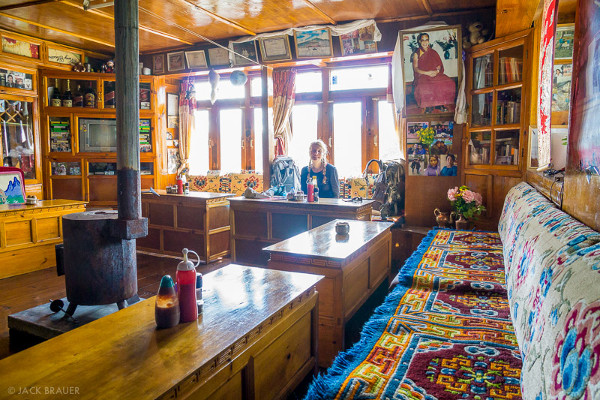
A night at these types of teahouses will cost anything from $3 to $10 a day. Prices get higher along with altitude and remoteness. Facilities will be rudimentary on less popular trekking routes.
Rooms, Electricity and Charging Points In Nepal Tea Houses
Generally, rooms are set up as twinshare. Twinshare rooms feature two beds with a mattress, pillows, duvet (blanket) and sheets.
Hygiene throughout most tea houses is not fantastic. We recommend putting a cover over the pillow and using a sleeping bag. It can get very cold at night, particularly higher up, so using a four-season sleeping bag is recommended. Walls are not insulated and are thin, making earplugs a wise choice.
Most tea houses will have basic access to electricity for lighting and central plug points in the communal restaurant for charging devices like mobile phones, tablets and eReaders. Teahouses will charge between $3-$5 to charge your device. Please note that access to charging points are often limited in the busier tea houses where demand for charging points are high.
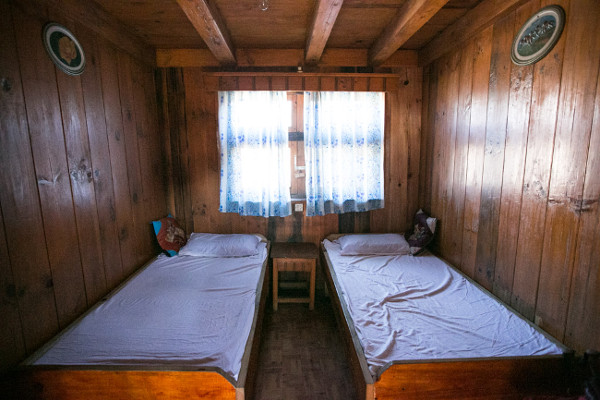
Food in Nepal Tea Houses
Nowadays, tea houses on the most popular trekking routes offer a wide choice of beverages from traditional tea to beer and a large food menu. Drinks and snacks (like crisps and chocolates) increase in price as you ascend in altitude.
Generally you can get a variety of rice and noodle dishes in every tea house. The standard combination is a mixed vegetable rice or noodle dish with a choice of beef or chicken.
We recommend not eating meat after Namche Bazaar on treks in the Everest region and after Chame in the Annapurna region. Dhal bhat – rice and lentils – is the national dish, which will be available at every tea house and is a great shout!
Many tea houses will also serve basic cheese and vegetable pizzas, garlic soup, omelets and chapati.
For breakfast you will have a choice of boiled eggs, omelets and porridge.
Ready to hike to Everest Base Camp? Check prices for your EBC trek with our preferred local guides.
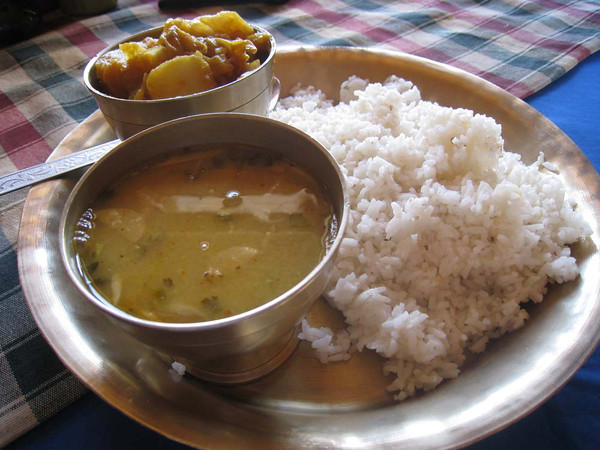
Other Important Considerations
If you wish to stay in only good-quality tea houses in Nepal, you should stick with inhabited areas on better-known routes.
There may be no food if you pitch up late, after 19:00. In the busier seasons of March to April and October to November, accommodation may not be available in the best tea houses. During these months, you may need to settle for more basic accommodation.
Nepal Tea Houses FAQ
If you have any further questions about Nepal tea house, please leave a message below and we’ll get back to you within 24 hours! Thank you.
Photo Essay Of Nepalese Structures, Views and Tea Houses
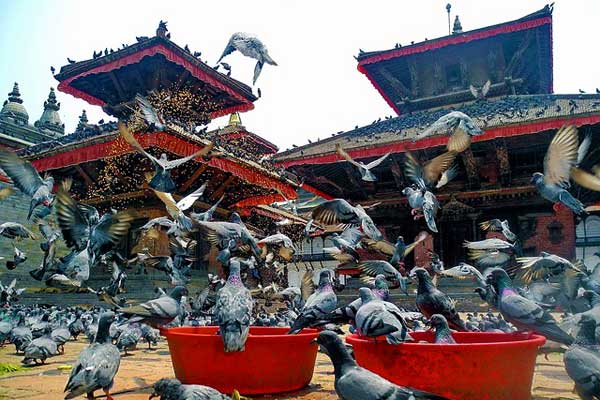
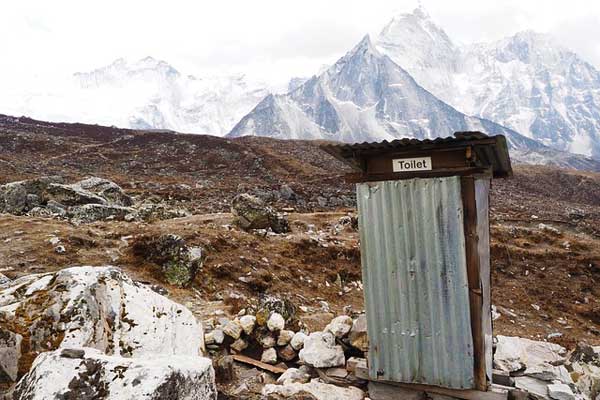
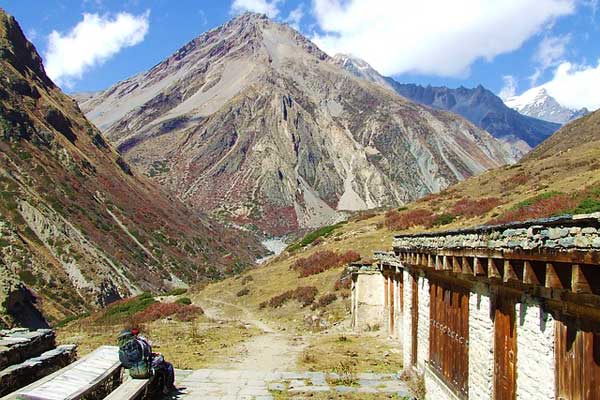
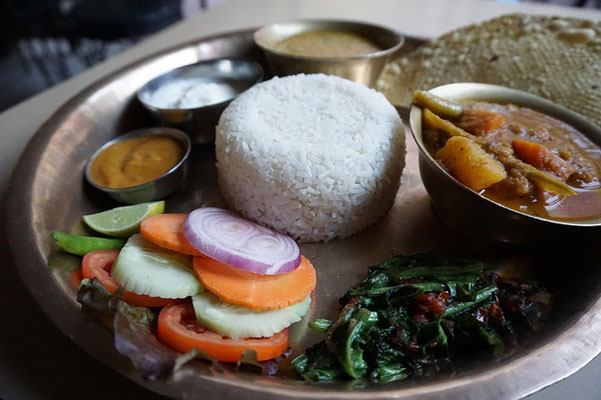
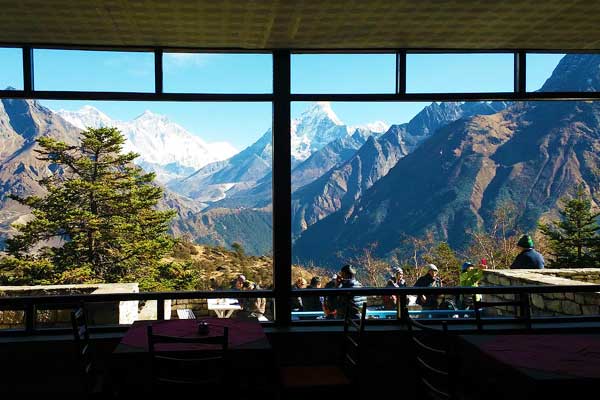
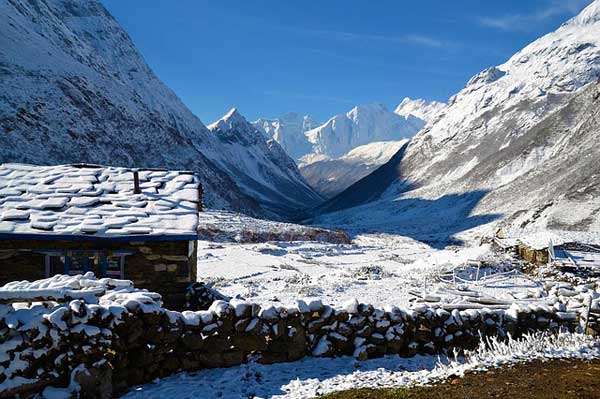
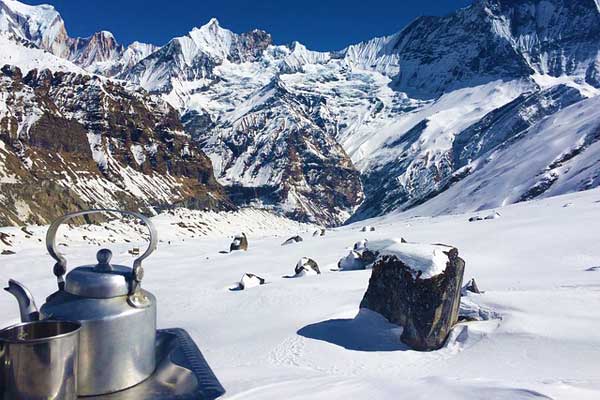
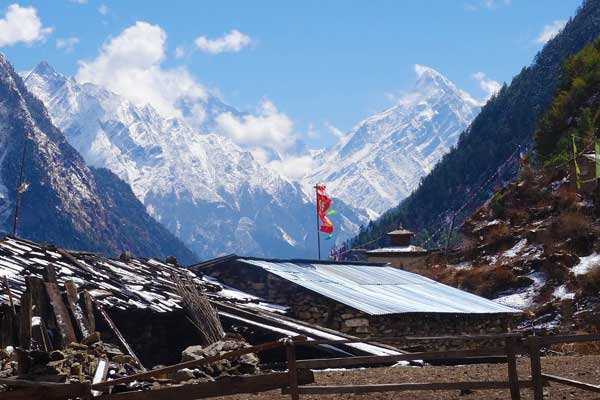
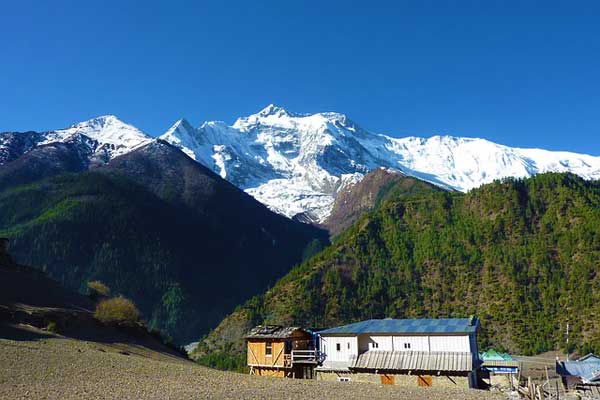
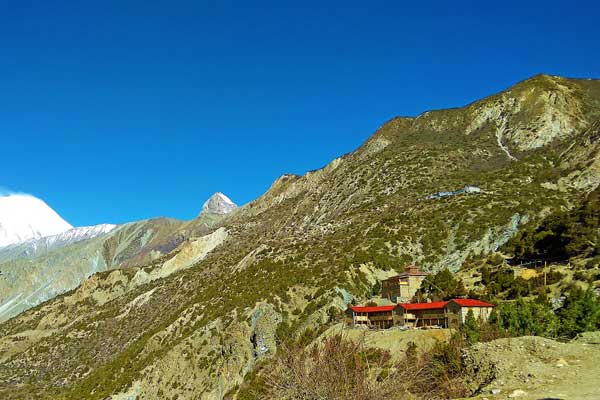
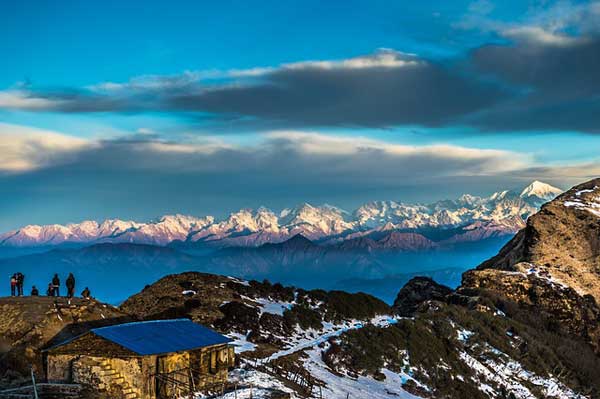
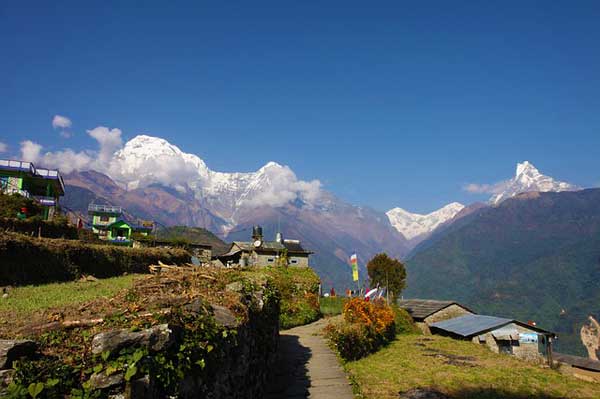
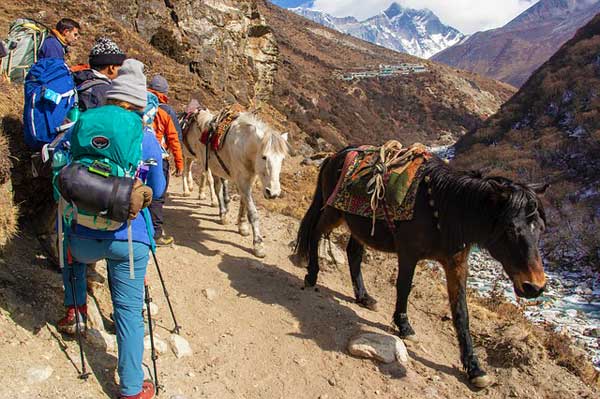
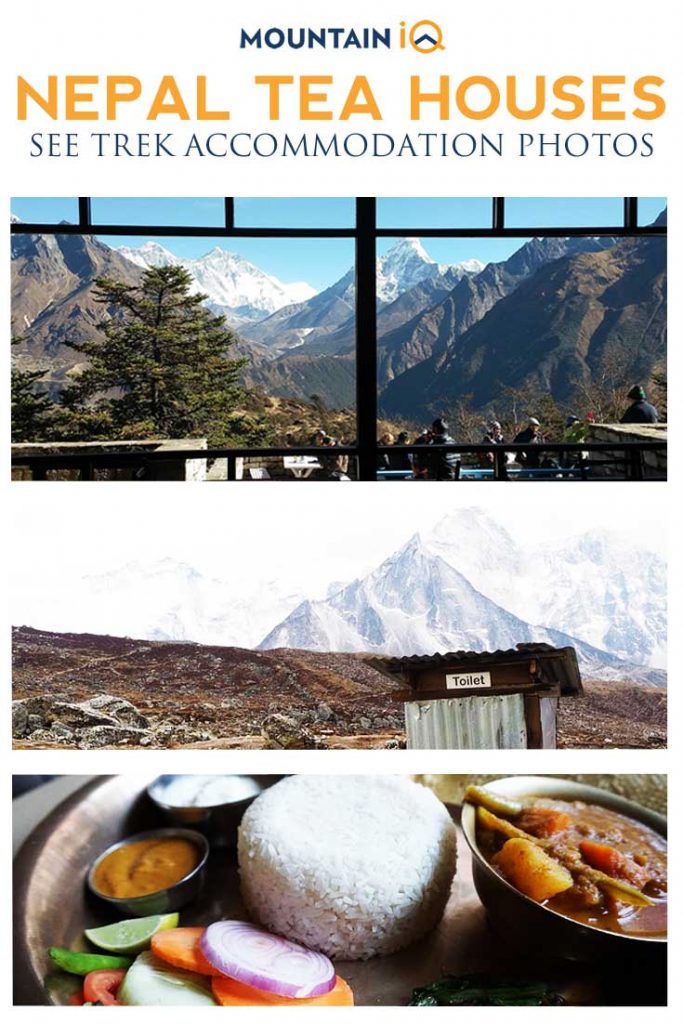

Fascinating blog post! I’ve always been intrigued by the concept of tea houses in Nepal and the unique cultural experience they offer. Your post has given me a better understanding of what to expect during my visit. Can’t wait to try some of the delicious tea and experience the local hospitality!
Hi Andrew,
I'll be doing my EBC trek solo in March 2024.
Is the trail snowy around that time?
Do you have any contacts of teahouses through the trek, so that I can pre book them?
Thanks in advance
Hi Palash, March usually doesn’t see much snow, although it is always possible to encounter snow higher up on the trail. Unfortunately it has been many years since I was in Nepal so no active contacts left.
Hi Andrew
Are the mattresses in tea houses likely to aggravate back issues or are they of a reasonable standard?
Hi Anne, mattresses tend to be very basic and may very well aggravate back issues.
HI Andrew, can I use some of your pictures for a travel website that I am building for Nepal?
Sure, but please attribute them with a link back to our site. Thanks
We are planning on a trip to Nepal and thinking about staying in teahouses that I had a question about whether they are likely to have animals in the house as I am severely allergic to cats and dogs and any animals. Do you think this would be a problem?
Hi Ellen, in my experience I haven’t seen too many dogs or cats inside teahouses, although undoubtedly there are will be some teahouses with a resident dog or cat. Animals are usually kept outside. There are also lots of teahouse on offer in most of the villages so you can always check their policy before bedding down for the night. All the best!
I’m a retired teacher wanting to go trek the Annapurna circuit – I missed my chance when I was in Kathmandu in 95. Anyhow any tips would be so appreciated! When’s the best time that’s a bit less touristy but weather still okay? is it still fairly safe traveling alone? Any tea house recommendations? Thanks in advance!
Josh Risley, Northern California
Hi Josh, the best time for the AC hike is April/May or September/October. You should be just fine travelling solo, although it’s worth taking a guide or porter for wayfinding, company and booking the best teahouses if they scoot ahead of you. On the teahouse front they are so varied across the different villages. Your best bet is having a guide/porter who goes ahead of you each day to secure the best teahouse in each village – they will also have much more local knowledge of teahouses.
Hi Mark,
Thanks for the info- these comments are really helpful. I have a year to figure things out and then hopefully just go with the flow. I’m wondering once I’m In Kathmandu if I should take a bus to Pokara and shuttle from there?
Hi Josh, the bus to Pokhara is quite a journey. Totally doable, but quite long and bumpy. Flying to Pokhara is a lot faster and easier.
Hi there! Thank you for this article! I am from Canada and I will be doing my trek in just over a week. I cannot find a definitive answer as to what type of electrical plug I need to bring with me to Nepal. Are you able to advise? I read there are three common ones (D, M and C) but is there one that is common in tea houses?
Thanks,
Jessika
Hi Jessika, yes, it is pretty confusing. The most common plug socket in Nepal is the European two pin plug, but you will also see that the Indian three-pin plug is used in some places. To be prepared for all options I recommend that you purchase a universal travel adaptor.
Bonjour,
J'espère que vous allez bien. Y a t il une possibilité de reserver des tea house à l'avance? Et si oui comment ?
Merci d'avance
Cordialement
Virginie
Generally you can’t book teahouses in advance without the help of a guide or getting a porter to run ahead each day to secure your place.
Great tips thanks! Is it common to just show up along the Annapurna Base Camp trek and hope for accommodation at teahouses or do they need to be pre-booked? Do you know if it's common to have issues finding accommodation or is there usually enough space even if at lower quality teahouses?
Hi Maria, Generally you should be fine. You might not get the nicest tea houses but you should be able to find accommodation without pre-booking. I recommend taking a porter with you who can rush ahead each day and book accommodation for you.
Greetings, my question is, do any of the tea houses or places one would stay along the trek to base camp have heat in the bedrooms? I mean REALLY WARM HEAT THAT IS COMFORTABLE. Also, can one take a helicopter on the return trip from base camp as opposed to hiking the entire route again?
Hi Craven, I’m not aware of any teahouses above Namche that will have heating in the bedrooms. There may be some but I would say the vast majority don’t have this. The rooms get very cold at night higher up the trail so make sure to take a warm 4-season sleeping bag. As for helicopters, it is possible to hire one from Gorek Shep. You can also get a helicopter from lower villages like Dingboche.
Thanks for writing this page, I’ll be on the annapurna circuit this winter and am a vegan. Do you think I’ll have any trouble finding vegan meals to eat, especially breakfast? I’m not sure what exactly porridge is. Also do teahouse rooms usually have electric lights. Thanks
Hi, most Nepalese are vegetarian with their staple diet consisting of Dal Bhat (rice and lentil / veg soup), so you should be good to go on that front. For breakfast though, eggs are quite a common dish so that would be problematic. I’m not sure if they use yak milk in porridge – you will need to check, but I’m sure they can make porridge with water instead. Generally the options for vegetarians are good, but not sure about vegans. In terms of electric, some tea houses are connected in some shape or form to the grid and will have lights in rooms, but many don’t (which means having a headlamp is important). All the best!
It may be necessary to carry some sort of foods for breakfast. I was thinking of bringing a supply of Butler Soy Curls and Instant Quinoa Flakes with some spices for breakfasts (would have to bring it from the US in my case). butler Soy curls are a whole food, it is minimally processed. Both are dry and relatively light. Pea protein crumbles are another option but I dont find them as satisfying.
Why is it that you do not recommend eating meat after Namche Bazaar? Thanks.
My fiance and I plan to trek to Annapurna Base Camp in October. We do not want an organized tour, but I am wondering if there are companies that would book tea houses for us in advance so we have a guaranteed place to sleep each night (especially as this will be the high season). Any suggestions?
Hi can you help, I am looking at doing EBC with a group friends and kids so 10 of us in total, I was looking at getting porters to help with carrying our kit so the kids don’t struggle much. Will I be able to find porters when I get to Lukla. How many porters would I need {is it 1 to 2 of us? so 5 in total} what sort of cost would a porter be for a day? Sam
Hi Sam, yes, you can arrange porters in Lukla. Generally 1 porter can cary 2 bags, so 5 in total should be fine. In terms of cost, these vary for $8 per day per porter on the low end, up to $20 per porter per day. I would budget $10-$15 per day per porter.
Are there teahouses with 3 beds in a room? There are 3 of us who want to travel together.
Some teahouses have three or four to a room, but most are two beds to a room.
Hello! First thank you for this page, it’s been useful for me 🙂 Me and my friend are going to Nepal next week, we plan to do the Annapurna Basecamp Trek at the end of November. We would like to try it without a porter first. But it is possible to take a porter in the middle of the trek, in case we change our mind? Also, if we do it without one, do you think we will have trouble finding rooms at the teahouses?
Thank you in advance 🙂
Hi Cyrielle, thanks for getting in touch. You should be okay in terms of availability as November is the tail-end of the season. If you decide to take a porter half way through the trek you should have no problem finding someone in one of the many villages who would be delighted to help!
Hi there!
Myself and my boyfriend are currently planning our trip to Nepal next April and we are trying to organise our Mt. Everest trek!
We really wanted to do the trek independently, to save some money but also because we both love the adventure of doing it alone!
However, I have read and been told that id planning to do the trek in April that it is recommended to go with a guided trip as tea houses can be extremely busy and could sell out of rooms. With that in mind we are now not sure what the best option for our trip is. If you can spread some light on this for us, that would be great! – Is the possibility of having nowhere to sleep some nights quite high? Or does it just mean we have to hunt a little longer and harder to find somewhere to sleep each night?
Thanks!
Hi Katie, yes, April and May are the busiest months of the year as it coincides with the Everest climbing season. Teahouse availability gets a little sketchy as you go north of Namche. My recommendation if you want to do the trek independently is to use the services of a porter to accompany you on the trek. He can then run ahead each day to secure a room for you guys in a suitable teahouse. All the best!
Do you have to stay in tea houses in order to buy food. In case tea houses are too full (going in October), I might have to sleep outside in tent, but don’t want to carry food. Thank you,
Devyn
Hi Devyn, you can just eat in a teahouse.
Do tea houses in Nepal poon hill trek have ice for a bad knee.
Hi Robert, unfortunately I can’t give you a definitive answer on this, but I would say it is unlikely.
Hey! I’m going to hike Gokyo Ri. As a solo hiker oct 22-nov 5. Any suggestions on tea houses? Do I need to book in advance? How about water? Should I bring a steripen? How safe is the water and food to drink? Thanks!
Theresa
Hi Theresa, You generally don’t need to book tea houses in advance, although many trekkers will employ the services of a guide / porter who can run ahead each day and secure the best teahouse for you. Trekking companies usually have priority as they bring a consistent flow of groups throughout the season, so you may find you don’t get the best teahouse picks. Yes, you need to either use a steripen or water purifying tablets – I recommend using both to be extra cautious. In terms of food, here is some useful information: https://www.mountainiq.com/food-and-drinking-water-on-an-everest-base-camp-trek/
Hi. Wondering if tea houses or home stays are available on the Dhaulagiri circuit? How far apart? Thanks, Kamala
Yes, there are teahouses on the Dhaulagiri Circuit. You can find out more here: https://www.mountainiq.com/guides/trekking-in-nepal/routes/dhaulagiri-circuit-trek/
Hi Andrew,
Do I need a 4 season sleeping bag for the tea houses, if I do the Ghandruk Trek only. I’ll not stay above 2000m. I am planning to go by the end of march 2019. I thought bringing a 3 season sleeping bag (Marmot Ultra Elite 30).
Thank you for your help.
Jean-Claude
Hi Jean-Claude, you should be fine with the Marmot Ultra Elite 30 on the Ghandruk Trek. All the best!
Hi ,I’m going a trip from Lukla too base camp .. without a tour .. will I be ok just turning up on a daily basis too a tea house .. I notice it’s difficult too pre book a tea house .. just in case I can’t get a place too sleep for the night .. should I be ok ?
Hi Mark, you should be fine, although you may find that the best teahouses are full in the smaller villages. You may want to employ the services of a porter who can run ahead everyday to secure you a room in the best teahouses.
Hi !
Wanted to know if you got knowledge regarding mount Makalu Barun valley route. Is there any tea house accommodation available after yangle kharka. After it comes merek and shersong ..want to stay as near as possible to Barun valley.
Hi Madhurima, Unfortunatley I haven’t trekked in the Barun Valley. Can any readers help Madhurima?
Hi!
I was wondering what is the typical cost of the meals offered so that I can budget? Or is it a thing that you pay to stay there and meals come with it?
And then for charging electronics— is it the $3-4 and hour, and what kind of converter is needed? Sorry last thing haha, on these treks, do any tea houses offer laundry of any sort or is there anything like that on the big routes?
Thank you so much!
Heather
Hi Heather, thanks for getting in touch. Meals are generally offered separately from your night’s accomodation. Meals with drinks cost between $4-8 dollars. So you should budget between $20-$30 for breakfast, lunch, dinner and snacks. Charging costs vary by teahouse. Generally they will allow you to fully recharge your device for $3. Laundry is generally not offered. You can obviously do some washing in the sinks, and then dry your clothes overnight. Hope this helps!
Hey nice page. I read it carefully before heading over there! Just a little updating from April 2017. On the Annapurna circuit I found phone charging was free until the highest area at Thorong Phedi. Then it was like 100r and just an honor system. Many rooms on the way up have a combination light switch and power socket. No charge for charging. I had an awesome multi charger with the right options but I found the Australia plug was often the best because it just fitted and held the charger in securely. BTW that charger was the best. Its a slightly rounded block with 4 sliders for 4 different plugs, like one of those writing pens with multiple colours. It also has two good USB sockets on one side so it’s all I brought.
I made up a 100ml bottle of dish detergent and I used most of it handwashing a bucket of hiking clothes each arvo. Then they always dried overnight in the dry mountain air, even at cold temps. I had clean clothes every day for maybe 10 minutes of effort.
Amem to the pillow case and sleeping bag – this was great advice from multiple people. I used my pillow case every night and bought a big -10C down bag that was sweet. Essential I’d say. Mine is a Sea to Summit base camp 2 – roomy for me, too big for some. Coldest night was -18C at high camp, which was ok in the -10 bag, liner and thermal layer with beanie. Beds come with one decent blanket each, lay it under the sleeping bag. Can get second blanket to go over top but they crush the down. If too cold, my suggestion is putting your goretex jacket over the top.
Test and buy the cheap crampons in Manang. They’re 2000r and I so wish I’d had them coming down the other side of the pass in the slushy melting snow. The 2000r hiking poles from KTM saved me then. Didn’t use them until the highest days up and down… essential.
My biggest discovery – get good sunscreen lip balm and use it all day every day! My lips were burnt and peeling by the pass, including inside my bottom lip. Two weeks of discomfort. Not good. Couldn’t eat any of the yummy curries after that. And sunglasses are so critical that you need a spare pair – you can not do the pass without them. People get snow blindness and get choppered out.
Oh, and the altitude. It doesn’t matter how fit you are. If you ascend too fast, your chances of AMS are very high. One guy told me almost half the choppers he orders are for Israelis who’ve just completed their two years of service – young, the fittest they’ll ever be and unwilling to heed the warnings. Be warned – fitness is basically a risk factor for AMS. There is a daily medical briefing in Manang – go to it on your rest day there. Great, practical explanation of the stages of AMS. I took a diamox pill every morning from maybe 2700m.
Finally, take the high route on the eastern side of the valley from Pissang. Cross over and stay in upper pissang. Then walk along and up to Ngawal (a sharp little 400m climb) and stay there or around further at 3700m. Then it’s a descent to the valley and along the flat to Manang. Do not skip the rest day in Manang though – you might feel great but the altitude is a serious risk.
I could go on lol. I don’t like heights and the lack of guard rails everywhere there but I am already planning to go back for EBC in 2019. It’s that good.
John, many thanks for leaving all these awesome insights on your Annapurna Circuit hike! I will no doubt update some of the content with your nuggets of wisdom! Thanks!
I’d love to locate a blog or list of the best tea houses to stay in while doing Annapurna Circuit. Can you give any recommendations?
Hi Noreen, that’s a great idea for a blog post. We’ll knock together one soon. In the meantime you might be able to cobble together suggestions by Googling the village name + teahouses to get recommendations.
Hey there are so many that you can’t really go wrong. In every town people are waiting, often outside the town saying “Namaste” and offering a room for the night. Maybe check the places out first and be prepared to move on. There is a tendency for newer tea houses to get built on the front edge of town but some of the best are further along. Most pricing is standardized, by law. Bigger ones generally have “attached” rooms available with toilets, some squat, some western. In Manang there is a big one on the left about half way along – 3 stories high with a low fence and courtyard area out the front.. It’s got the bakery out the front. Very good for two nights. I highly recommend the main one at Thorong Phedi that is run by the rasta guy. He’s the son of the man who built it originally. Then there is a definite leading one over in Mucktinath – the Bob Marley! It’s big and awesome. I squeaked into the last available room right down in the lowest level and was so glad. Hey I travelled solo and unless the place is full, they just give you a double room for yourself. No extra charge.
Hi there. I’m planning on trying to do the Annapurna Circuit and Everest Base Camp trek within a 35-37 day window from mid Nov to mid Dec this year (2017). Firstly (knees depending!!) is this possible, secondly I know this is a peak time of year what happens if the teahouses book up? I’m a reasonably fit 38 year old male (whose just climbed Kilamanjaro in 5 days) and will be doing the trek solo. Cheers Pete PS – Also would you recommend carrying a sleeping bag or is this overkill?
Hi Pete, yes, it is possible to complete the EBC trek and Annapurna Circuit in that timeframe. In terms of teahouses, both these routes are very well trodden with many small villages to stop overnight. You shouldn’t have a problem finding accommodation, although you may not get your first choice. If you are taking a guide or porter (which is worthwhile, for the company at least), then you can always get them to walk ahead and make a booking for you. Finally, a sleeping bag is an absolute must. You definitely want to a good 4 season sleeping bag. Whatever you used on Mount Kilimanjaro will suffice on the EBC or AC routes. All the best!
Wondering if there are Tea houses near Namo Buddha?
I want to go there but the monastery has informed me their guest house if fully booked and there is an eco resort which is way over my budget.
Do you know if there are home stays or tea houses around?
Kind regards,
Johan
Hi Johan, I haven’t been to Namo Buddha so unfortunately can’t comment. But according to this wikitravel article it looks like there are a few accommodation options: https://wikitravel.org/en/Namo_Buddha
Hey hey !
What about wifi in teahouses?
Hi Lama, most teahouses in the Everest region have wifi or you can get connected using EverestLink. Read more here: https://www.mountainiq.com/internet-access-on-an-everest-base-camp-trek/
Hi Andrew,
I don’t know if you are still receiving these, my son is about to go on the “Three Passes” , Which does include Everest base camp
He recently stayed in tea houses and he quickly got a fever, and diarrhea, and felt that the food he was served, he had no options in terms of trying to protect myself
He does have his own drinking cup, but other than that, if everyone is being served the same food, how can one avoid getting travelers diarrhea?
You also mentioned that after a certain place, don’t eat any meat.
Is it because it’s likely to be contaminated?
It’s a three week trek, and along that route, options about the quality of tea houses, and if so, are there any strategies about getting a tea house, if there is a choice, that is less likely to cause health issues ?
Thanks for your time and expertise
Don
Hi Don,
Unfortunately hygiene standards in most teahouses are nowhere near Western standards so one always runs the risk of getting a stomach bug. My recommendation is to try stay in the best looking teahouses (i.e. not the ones that are super cheap!). The better teahouses usually have better kitchens.
Make sure your son never drinks the water unless he has purified it. Water purification tablets work well. This includes not brushing your teeth with water that hasn’t been purified.
Order simple cooked foods (no raw foods like salad) – pasta with vegetables, porridge, sherpa stew is usually good, boiled eggs etc. Avoid meat as it is against Buddhist tradition and law to slaughter animals above Lukla. This means that any meat sold in teahouses is usually bought in Lukla and walked to the teahouse in question (some of these journeys can be two days long!). It therefore has a higher probability of contamination. You can sometimes get away with eating chicken, but its worth asking the teahouse owner where and when the chicken was killed.
Apart from that be meticulous at cleaning your hands – take anti-bacterial hand-gel and be vigilant in what you put in your mouth.
Hope this helps!
Hi Andrew! Thank you for a great blog! I would like to ask you if there is any GPS map where to find the tea houses? I would also like to have you opinon about biking (mtb) in Nepal! I would like to bike the great Himalayan route. Thank you for your help! //Peter
Hi Peter, Maps of the Everest and Annapurna region are pretty good, and do show the coordinates of villages. You can pick up a map in Kathmandu. As for mountain biking, the Annapurna region is your best option, you may be able to do short sections of the Great Himalayan Route in the Annapurnas. Further afield and I’m afraid I wouldn’t know. All the best!
Hi, thanks for all the information. I am not reading a lot about the toilet accommodations. If you have a full tea house and communal toilet or squat, will people be lining up holding it in? I will be doing the AST in October with a guide company out Australia.Also, would you recommend high trail shoes and regular. My husband wants to bring both and it seems like regular would be sufficient in October. Thoughts? Thank you
Where can i book teahouses please. There must be general website as last time i went they were all prebooked rooms. Theres 7 of us in april/may so its best to prebook
Hey Kayleigh, most teahouses can’t be pre-booked. You may be able to find some teahouses in Namche where you can prebook. The best way to secure teahouses is to send a porter or guide ahead of you on the trail. He will get to villages a few hours before you and most other groups on the trail and can get rooms at the best teahouses.
Thank you for your last response! I have a couple of down sleeping bags and am wondering what degree bag to bring for the ABC trek in October. I understand the tea house bedrooms can be quite cold.
Is there any way to book teahouses ahead of time? We are planning to arrive to kathmandu April 18. Is that so busy that it will be hard to find a tea house?
Hi Megan, unfortunately almost all teahouses can’t be pre-booked. If you are taking a guide or porters they usually charge ahead after lunch to secure rooms in the best teahouses, otherwise you might need to shop around when you get into a village to find a room. All the best!
Hi Andrew!
I would like to do the EBC in April this year without a guide or porter, but am concerned about teahouse accommodation availability. Do you have to book in advance somehow?
Thank you!
Hi Megan, You should be fine, although you might not get your first choice. Cheers!
Hello,
I will be doing the ABC trek in October 2017 with 3 other fit women. We will have a guide and porters. Is it necessary to carry all water for the day in our day packs or will there be chances to refill water during the day? I have a Steri Pen.
Thank you!
Hi Patti, you will be able to get water refilled each day at the tea houses you use along the route. You will start each day with about 2-3 litres and by the time you reach your tea house for the evening you can refill your water. Good to hear you have a Steripen to filter your water. All the best!
Hi Andrew,
I´m planning on doing the EBC Trek with my girlfriend in March 2018. We definitely want to do it without guides and porters.With other people sending their guides ahead and all, Is there any chance we will have difficulties finding a teahouse to stay at? We don´t care if the “good ones” are all full by the time we get to the village every night, as long as we have a place to stay..
Hi Lasse, you should be fine finding accomodation in March. There are loads of teahouses scattered along the trail. The only two villages that have limited options are Lobuche and Gorek Shep, but generally you should be fine. All the best!
Hey I reckon you’ll be fine. March April is the quieter season and I had no trouble on Annapurna, in those months, even taking my time. On that trek there are some places with tea houses that are much nicer. They fill quicker. I had no issues with walking without guides or porters. My pack was about 12kg plus water and I found the Nepalis did their best to be understood in English. If you’re trying too, you’ll be fine.
Hi Andrew, might you please tell me something about the possibility to sleep in your own tent and buy food you cook on your own cooker along the EBC and 3 Passes trip?Is there something like markets where i can buy elementary food?
Hi Andrew,
Thank you for the post. Very useful. I am going to EBC with a friend this April.
We are planning to trek via the Gokyo lake as the route is more scenic.Can you please advise if we will get accommodation without prior booking?
we will be travelling with out a guide / porter. Could you also please advise if it is advisable to travel with out a guide ?
Hi Ganesh, you can do the Gokyo trek without pre-booking teahouses, however I would recommend taking a guide or porter to help with wayfinding, additional safety and they can run ahead each day to secure teahouse rooms for you. All the best!
Hi Andrew, I am a type 1 diabetic so am trying to work out what supplement foods to bring. Can you tell me if the rice served in tea houses is basmati or not. Weird i know but I need low go options to manage blood sugar at altitude. Thanks
Hi Marisha, in my experience most teahouses serve standard rice, not basmati. You can always bring your own rice and ask the kitchens to cook it for you. Hope this helps!
My friends and I will be doing the EBC trek in April. From the research I’ve done I understand April is a busy time for the trek. Is it necessary to bring a tent as a back up plan in case no room is left in any of the tea houses?
Hi Joe, It is very unlikely that you won’t find available accomodation. Gorak Shep can get busy but other villages are well stocked with tea houses. I recommend sending your guide / porter ahead to reserve rooms each day. All the best!
What is the distance between tea houses? Is there a gps map that you know of?
Hi Matt, the distance between tea houses is sometimes as short as 2-3 km and as long as 8-10 km. There is usually a tea house stop every few hours on the Everest Base Camp trek.
That’s what I figured- it’s been very difficult to find any info at all and I was hesitant to take the risk. But adventures are always more fun with a pup… thank you so much for your time. Loving the site.
Hi Andrew,
Thanks for the post. I’m keen to bring my (small) dog along for some trekking. He’s been on many long hikes before and never runs out of energy, but is calm indoors. From your experience, would tea houses allow for a small pet or is it more likely that the majority of places would refuse to allow him inside? My other concerns in the region were traveling with him on buses and trains.
Thank you/baie dankie.
Hi Alex, thanks for your question. To be honest, I don’t have a conclusive answer. I suspect most tea houses would be okay with him, but not sure whether they would allow him in your room. Sorry I can’t be of more help. In general I think it will be tough to travel with him in Nepal. Trains / buses and internal flights are not really equip for travelling with pets. That being said, it is always possible to negotiate your way into options so if you are willing to wing it then it could be a real adventure. All the best!